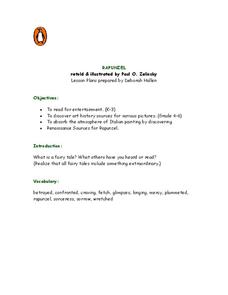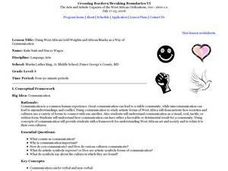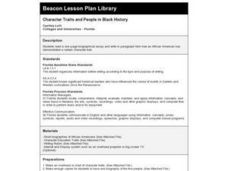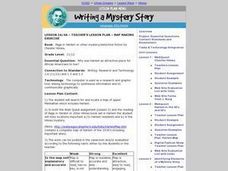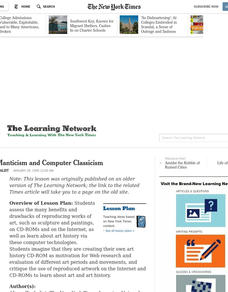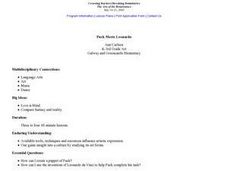Curated OER
Experiencing Japanese Feudalism
Young scholars identify that a system of feudalism similar to that of medieval Europe developed in Japan by 1300. Students identify the social hierarchy of feudal Japan. Young scholars identify what the cultural basis for the...
Curated OER
Calligraphy, Handwriting And The Alphabet
Students produce calligraphy projects using writing skills and unique tools in this six-day Art activity. Emphasis is placed upon the work of Portland, Oregon calligraphy artist Inga Dubay and her experiences with "Italic" writing...
Curated OER
Rapunzel
Youngsters read the story of Rapunzel and go over vocabulary and answer discussion questions. They also list qualities of characters, discuss settings, make a diorama, and more.
Curated OER
Columbian Contexts
Students explore geo-political and economic contexts for the European Renaissance journeys of exploration, including those of Columbus, create cartographic symbols, and add those symbols to a print-out of Ptolemy's map.
Curated OER
Double, Double, Toil and Trouble: A Dual Exploration of Macbeth
Young scholars emulate a key practice of Renaissance theater: doubling. The goal of this lesson is for students to experience-to see, hear, and feel-the differences between characters. Each group presents scenes to the rest of the class.
Curated OER
The Flights Of The Phoenix
Students investigate the use of the Phoenix in Japanese and Chinese art while making connections to the use of the Phoenix in the book Fahrenheit 451. This instructional activity can be adapted for grades 8 through 11 but was originally...
Curated OER
Using West African Gold Weights and African Masks as a Way of Communication
Eighth graders discuss how communication, or lack thereof, can have either a favorable or detrimental effect on a community. They study and interpret proverbs as a means of teaching a lesson. Finally they discuss symbolism and design a...
Curated OER
History of Chemistry: The Alchemists
Students research alchemy and the history of chemistry. In this chemistry history lesson, students examine laboratory apparatus and compare it to those used by the Alchemists. Students complete a research paper on an important...
Curated OER
Who Am I? My Coat of Arms
Fifth graders put their coat of arms on a HyperStudio card. They explain in three paragraphs why they selected the pictures.
Curated OER
Irish Literature Scavenger Hunt
Fourth graders locate and evaluate various books, journals, anthologies, and Internet sources that contain information that may be used in answering the scavenger hunt questions related to Ireland and Irish literature.
Curated OER
Character Traits and People in Black History
Third graders, after reading a one-page biographical essay, write in paragraph form how an African American has demonstrated a certain character trait.
Curated OER
Midsummer Night's Dream Unit
High schoolers use the Internet to research one of Shakespeare's plays. They read two myths and create their own script for the play. They also examine the history of Ancient Greece.
Curated OER
Deep like Rivers: Four African American Poets of the 1920s and 1930s
Students examine work by outstanding African American poets from the time period of the 1920s and 1930s. They study aspects of American and African American social, cultural and artistic history that influenced the content of some of the...
Curated OER
Map Making Exercise
Students complete a Web Quest in order to determine why Harlem was an attractive place for African Americans to live. They study a map of Harlem in the 1930's.
Curated OER
CD-ROManticism and Computer Classicism
Students assess the many benefits and drawbacks of reproducing works of art, such as sculpture and paintings, on CD-ROMs and on the Internet, as well as explore art history via these computer technologies.
Curated OER
Isn't It Romantic?
Sixth graders investigate the ideas, literature, music, and art of the Romantic Movement. They apply romantic ideals to their original writing and art, analyze poetry, discuss key vocabulary, and analyze artwork from this era.
Curated OER
Japanese Objects as Cultural Artifacts: A Model Lesson Using Textiles
Learners complete a unit on the cultural significance of textiles in the Japanese culturre. They analyze cotton, line, silk, and wool fabrics, examine various fabric creation and decoration techniques, select an object and write a...
Curated OER
African Amercan Images in Harlem (1920-1950)
Eleventh graders compare and contrast different representations of African Americans in Harlem using visual sources. They detect point of views, themes, contradictions and ironies in sources using designed templates.
Curated OER
Of Maps and Worldviews
Young scholars explore Ptolemy's world map as an expression of the Renaissance view of the world.
Curated OER
Revolutions in Latin America: Bolivar, 1813-1814
Students compare the leadership skills of Washington and Bolivar. In this Latin American history lesson, students read biographical information about George Washington and Simon Bolivar. Students compare the men to better understand the...
Curated OER
Own Goals
Learners explore steps to control football violence. In this current events lesson, students listen to a lecture about patriotism, policing, and films relating to British football. Learners debate the efforts taken in Britain...
Roy Rosenzweig Center for History and New Media
War and Poetry
A band of brothers or the Devil's agents? Nobel warriors freeing the oppressed or mercenaries working for the military/industrial complex? Groups examine poems from the Civil War, World War I, and World War II to determine the poets'...
Curated OER
Puck Meets Leonardo
Students create a puppet of Puck from the story read aloud. Then they identify how they can use the inventions of Leonardo da Vinci to help Puck complete his task. Students also observe the inventions of Leonardo from books and online...
Curated OER
Creating Context: The Printing Press as Impetus
Tenth graders examine the invention of the Gutenberg printing press and its effect on society. In groups, they research how much the press enabled various revolutions around the globe. They also identify the causes and effects of each...




